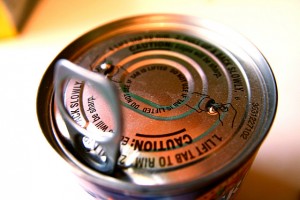Editor’s note: BPA is among the emerging contaminants that will be discussed Oct. 12-14 in Detroit at the 2011 Great Lakes Week. Detroit Public Television is providing ongoing coverage of Great Lakes Week at greatlakesnow.org
 Most pregnant women tested positive for chemicals linked to birth defects in a recent study by the Minnesota Department of Health.
Most pregnant women tested positive for chemicals linked to birth defects in a recent study by the Minnesota Department of Health.

Phenols, like BPA and parabens, are found in many food containers. Photo: stevendepolo (Flickr)
The pilot project, dubbed the Riverside Prenatal Biomonitoring Project, tested 66 pregnant women for cotinine, a chemical indicative of tobacco use, and environmental phenols, including bisphenol A (BPA) and parabens. Cotinine can cause premature births and other defects. BPA and parabens, found in plastics, food cans and cosmetics, alter fetal development, according to animal studies. Human tests have recently begun.
“Tobacco is already known to be harmful for pregnant women … we chose the phenols because a lot of animal studies suggest they alter hormone levels,” said Jean Johnson, program director of the Minnesota Biomonitoring Pilot Program.
While 15 percent of the women had cotinine in their urine, 56 percent had BPA. Two types of parabens, methyl paraben and propyl paraben, were detected in 94 percent and 85 percent of the women, respectively.
It is difficult to conduct human studies on BPA and parabens because scientists “aren’t going to expose people to something potentially dangerous,” said Dr. Hugh Taylor, professor and chief of the reproductive endocrinology section at Yale University School of Medicine.
Taylor has researched BPA’s effect on pregnancies in multiple animal studies.
“We’ve found that exposure to BPA in pregnant mice permanently changes the DNA of offspring,” Taylor said.
BPA has estrogen-like properties and affected reproductive function and fertility in Taylor’s animal studies.
“Exposure leads to estrogen sensitivity later in life, which can lead to uterine, breast and other cancers,” Taylor said
Parabens are also estrogen mimickers and engender birth defects, according to animal studies.
However, the research on BPA’s effects is conflicting.
In 2007, the National Toxicology Program released a report on BPA’s possible harm to the pregnant and the unborn. The panel used the very limited human studies and drew from the large pool of animal studies. The expert panel had “negligible concern” that fetal exposure to the chemical produced birth defects.
The report found many levels of uncertainty with information that’s been developed on BPA, so the panel recommended more research.
The Food and Drug Administration (FDA) expresses “some concern” at the potential effects of BPA and parabens on the unborn and continue to conduct research. Manufacturers are not required to disclose BPA-containing linings to the FDA.
There were three biomonitoring projects assigned to the Minnesota Department of Health in 2007 by the Legislature in addition to the prenatal study: studies on arsenic in children, perflurochemical’s (PFCs) in residents, and mercury in Lake Superior. The projects were designed to learn about chemicals in the state and to bolster biomonitoring capabilities. Human biomonitoring allows researchers to analyze toxic substances in people and contributes to health risk assessment and routes of exposure.
As a pilot project with few participants, the biomonitoring team planned to expand the research. Despite the pilot’s findings, they have been directed by the Legislature to not move forward.
“Unfortunately, the future is very uncertain,” Johnson said “Two other projects are still in process (the PFC and mercury in Lake Superior studies) but not this one due to budget issues.”
So while the Minnesota project is stalled, and uncertainty of phenols’ effect on pregnant women and their offspring remains, Taylor recommends all pregnant women play it safe.
“I think there’s enough of a red flag that lowering exposure is a good idea. When you’re pregnant, what’s the harm in eating fresh food instead of plastic container food?”
Pregnant women should be more careful than normal, chemicals are everywhere nowadays.
Metal Detecting
“..the future is uncertain.” That’s so deep. My life is changed forever.